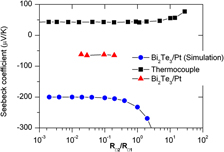Crossref Citations
This article has been cited by the following publications. This list is generated based on data provided by
Crossref.
Nguyen, Hai P.
Wu, Minxian
Su, Jiale
Vullers, Ruud J.M.
Vereecken, Philippe M.
and
Fransaer, Jan
2012.
Electrodeposition of bismuth telluride thermoelectric films from a nonaqueous electrolyte using ethylene glycol.
Electrochimica Acta,
Vol. 68,
Issue. ,
p.
9.
Nguyen, Hai P.
Peng, Xiaoxu
Murugan, Ganapathi
Vullers, Ruud J. M.
Vereecken, Philippe M.
and
Fransaer, Jan
2013.
Electrodeposition of Antimony, Tellurium and Their Alloys from Molten Acetamide Mixtures.
Journal of The Electrochemical Society,
Vol. 160,
Issue. 2,
p.
D75.
Rostek, Raimar
Kottmeier, Jonathan
Kratschmer, Matthias
Blackburn, Gina
Goldschmidtböing, Frank
Kröner, Michael
and
Woias, Peter
2013.
Thermoelectric Characterization of Electrochemically Deposited Bi2Te3Films Accounting for the Presence of Conductive Seed Layers.
Journal of The Electrochemical Society,
Vol. 160,
Issue. 9,
p.
D408.
Wu, Minxian
Nguyen, Hai P.
Vullers, Ruud J. M.
Vereecken, Philippe M.
Binnemans, Koen
and
Fransaer, Jan
2013.
Electrodeposition of Bismuth Telluride Thermoelectric Films from Chloride-Free Ethylene Glycol Solutions.
Journal of The Electrochemical Society,
Vol. 160,
Issue. 4,
p.
D196.
Schumacher, Christian
Reinsberg, Klaus G.
Rostek, Raimar
Akinsinde, Lewis
Baessler, Svenja
Zastrow, Sebastian
Rampelberg, Geert
Woias, Peter
Detavernier, Christophe
Broekaert, José A. C.
Bachmann, Julien
and
Nielsch, Kornelius
2013.
Optimizations of Pulsed Plated p and n‐type Bi2Te3‐Based Ternary Compounds by Annealing in Different Ambient Atmospheres.
Advanced Energy Materials,
Vol. 3,
Issue. 1,
p.
95.
Wu, Minxian
Binnemans, Koen
and
Fransaer, Jan
2014.
Electrodeposition of antimony from chloride-free ethylene glycol solutions and fabrication of thermoelectric Bi2Te3/(Bi1−xSbx)2Te3 multilayers using pulsed potential electrodeposition.
Electrochimica Acta,
Vol. 147,
Issue. ,
p.
451.
Rostek, Raimar
Stein, Nicolas
and
Boulanger, Clotilde
2015.
A review of electroplating for V–VI thermoelectric films: from synthesis to device integration.
Journal of Materials Research,
Vol. 30,
Issue. 17,
p.
2518.
Kim, Jae-Hwan
Kim, Woo-Jun
and
Oh, Tae-Sung
2016.
Thermoelectric Thin Film Devices for Energy Harvesting with the Heat Dissipated from High-Power Light-Emitting Diodes.
Journal of Electronic Materials,
Vol. 45,
Issue. 7,
p.
3410.
Wu, Minxian
Ramírez, Salvador Alvarado
Shafahian, Ehsan
Guo, Lingyi
Glorieux, Christ
Binnemans, Koen
and
Fransaer, Jan
2017.
Electrodeposition of bismuth telluride thin films containing silica nanoparticles for thermoelectric applications.
Electrochimica Acta,
Vol. 253,
Issue. ,
p.
554.
Recatala-Gomez, Jose
Kumar, Pawan
Suwardi, Ady
Abutaha, Anas
Nandhakumar, Iris
and
Hippalgaonkar, Kedar
2020.
Direct measurement of the thermoelectric properties of electrochemically deposited Bi2Te3 thin films.
Scientific Reports,
Vol. 10,
Issue. 1,





